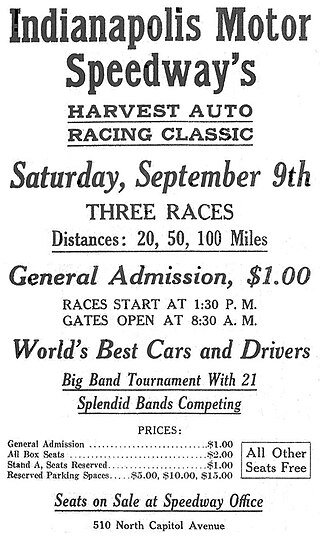Related Research Articles

Ray Wade Harroun was an American racing driver and pioneering race car constructor. He is most famous for winning the inaugural Indianapolis 500 in 1911.

Lewis Strang was an American racing driver.

Albert Francis Dingley was an American racing driver.

Race results from the automobile and motorcycle races contested at the Indianapolis Motor Speedway in Speedway, Indiana. Races have been held on seven different track configurations:

Edward Carl Bald was an American cyclist and automobile racing driver who was retroactively declared the 1907 AAA National Champion in 1951 by negationist sportswriter Russ Catlin. He was also a champion bicycle racer in the 1890s, nicknamed "The Cannon."
The 1910 AAA Championship Car season consisted of 19 races, beginning in Atlanta, Georgia on May 5 and concluding in Long Island, New York on October 1. AAA did not award points towards a National Championship during the 1910 season, and did not declare a National Champion.

The 1911 AAA Championship Car season consisted of 21 races, beginning in Oakland, California on February 22 and concluding in Savannah, Georgia on November 30. AAA did not award points towards a National Championship during the 1911 season, and did not declare a National Champion. Ray Harroun was the winner of the inaugural Indianapolis 500.
The AAA Contest Board was the motorsports arm of the American Automobile Association. The contest board sanctioned automobile races from 1904 until 1955, establishing American Championship car racing. Modern-day Indy car racing traces its roots directly to these AAA events.
The 1920 AAA Championship Car season consisted of 5 races, beginning in Beverly Hills, California on February 28 and concluding in Beverly Hills on November 25. The AAA National Champion and Indianapolis 500 champion was Gaston Chevrolet. The 1920 season later became a source of confusion and misinformation for historians when in 1926 the AAA published a revisionist history, naming another driver as the season's point champion.
The 1916 AAA Championship Car season consisted of 15 races, beginning in Brooklyn, New York on May 13 and concluding in Los Angeles, California on November 30. There were also 12 non-championship races. For the first time since the 1905 season, the AAA awarded points towards a National Championship. The AAA National Champion and Indianapolis 500 winner was Dario Resta.
The 1912 AAA Championship Car season consisted of 18 races, beginning in Santa Monica, California on May 4 and concluding in Brooklyn, New York on November 5. There was also one non-championship event at Milwaukee, Wisconsin. AAA did not award points towards a National Championship during the 1912 season, and did not declare a National Champion. Joe Dawson was the winner of the Indianapolis 500.
The 1913 AAA Championship Car season consisted of 14 races, beginning in San Diego, California on January 1 and concluding in Corona, California on September 9. AAA did not award points towards a National Championship during the 1913 season, and did not declare a National Champion. Jules Goux was the winner of the Indianapolis 500.
The 1914 AAA Championship Car season consisted of 15 races, beginning in Santa Monica, California on February 26 and concluding in Corona, California on November 26. AAA did not award points towards a National Championship during the 1914 season, and did not declare a National Champion. René Thomas was the winner of the Indianapolis 500.
The 1915 AAA Championship Car season consisted of 27 races, beginning in San Diego, California on January 9 and concluding in San Francisco, California on November 25. AAA did not award points towards a National Championship during the 1915 season, and did not declare a National Champion. Ralph DePalma was the winner of the Indianapolis 500.
The 1917 AAA Championship Car season consisted of 21 races, beginning in Los Angeles, California on March 4 and concluding there on November 29. AAA did not award points towards a National Championship during the 1917 season, and did not declare a National Champion.
The 1918 AAA Championship Car season consisted of 16 races, beginning in Uniontown, Pennsylvania on May 16 and concluding there on September 2. There were also 3 non-championship races. AAA did not award points towards a National Championship during the 1918 season, and did not declare a National Champion.
The 1919 AAA Championship Car season consisted of 21 races, beginning in Santa Monica, California on March 15 and concluding in Cincinnati, Ohio on October 12. AAA did not award points towards a National Championship during the 1919 season, and did not declare a National Champion. Howdy Wilcox was the winner of the Indianapolis 500.
The Merrimack Valley Course was a temporary street circuit in Lowell, Massachusetts. The 10.6 mile track hosted its first races in 1908 and was on the 1909 AAA Championship Car schedule. Due to financial losses, racing was discontinued after that season.
References
- 1 2 Capps, H. Donald (February–March 2010). "John Glenn Printz and the Struggle for the Past: The A.A.A. Catastrophe - Arthur Means, Val Haresnape, Russ Catlin, and Bob Russo" (PDF). Rear View Mirror. 7 (6): 21–38.
- ↑ "Two perished in auto race". The Evening Citizen . Ottawa, Canada. Associated Press. August 20, 1909.
- ↑ "Death claims further toll". The Evening Sentinel . Rochester, Indiana. August 23, 1909.
- ↑ "Fatal injury to man at Lowell". The Day . New London, Connecticut. August 31, 1909.
- ↑ "All records broken; spill costs one life". Daily Press . Newport News, Virginia. Associated Press. September 30, 1909.
- ↑ "Flying tire may cost man's life". Oakland Tribune . October 24, 1909. Archived from the original on July 31, 2018.
- ↑ "Victim of flying auto tire dies". The San Francisco Call . December 15, 1909.